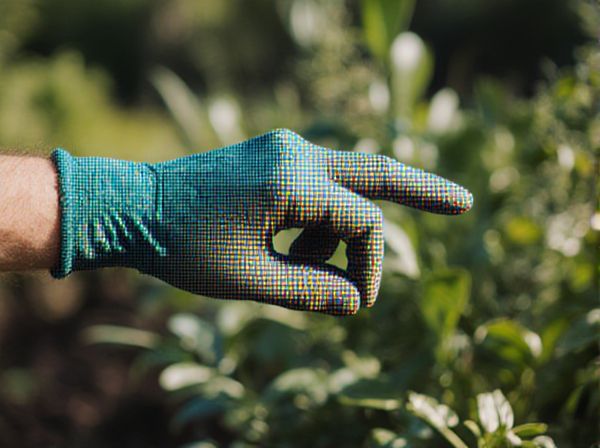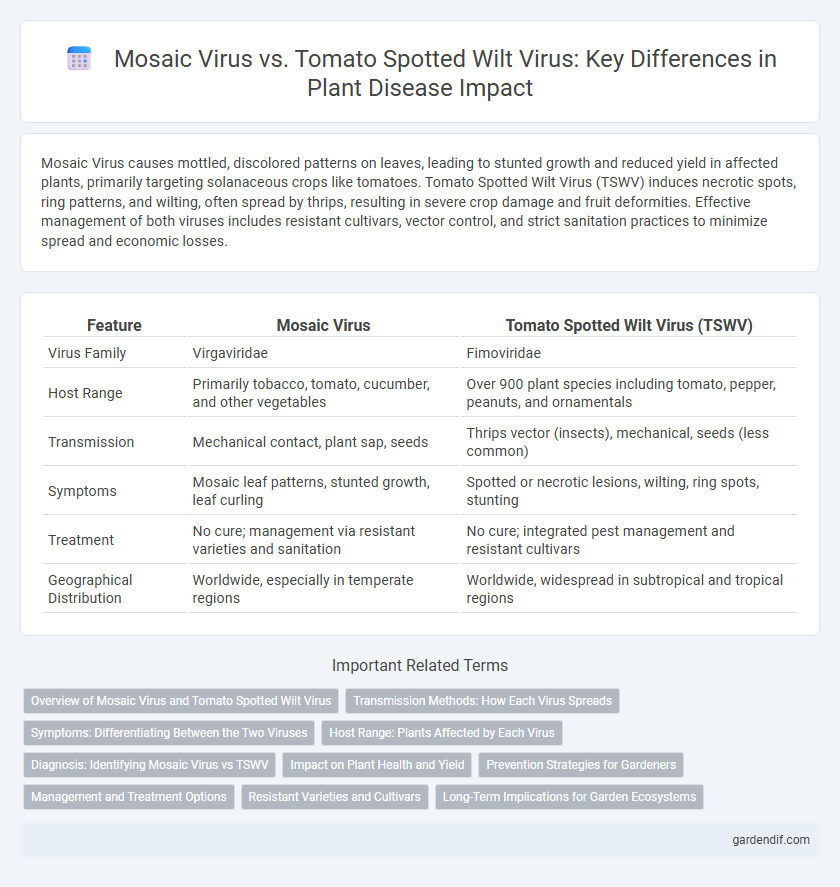
Mosaic Virus vs Tomato Spotted Wilt Virus Illustration
Mosaic Virus causes mottled, discolored patterns on leaves, leading to stunted growth and reduced yield in affected plants, primarily targeting solanaceous crops like tomatoes. Tomato Spotted Wilt Virus (TSWV) induces necrotic spots, ring patterns, and wilting, often spread by thrips, resulting in severe crop damage and fruit deformities. Effective management of both viruses includes resistant cultivars, vector control, and strict sanitation practices to minimize spread and economic losses.
Table of Comparison
| Feature | Mosaic Virus | Tomato Spotted Wilt Virus (TSWV) |
|---|---|---|
| Virus Family | Virgaviridae | Fimoviridae |
| Host Range | Primarily tobacco, tomato, cucumber, and other vegetables | Over 900 plant species including tomato, pepper, peanuts, and ornamentals |
| Transmission | Mechanical contact, plant sap, seeds | Thrips vector (insects), mechanical, seeds (less common) |
| Symptoms | Mosaic leaf patterns, stunted growth, leaf curling | Spotted or necrotic lesions, wilting, ring spots, stunting |
| Treatment | No cure; management via resistant varieties and sanitation | No cure; integrated pest management and resistant cultivars |
| Geographical Distribution | Worldwide, especially in temperate regions | Worldwide, widespread in subtropical and tropical regions |
Overview of Mosaic Virus and Tomato Spotted Wilt Virus
Mosaic Virus primarily affects plants by causing mottled patterns and distorted growth, severely reducing crop yield and quality. Tomato Spotted Wilt Virus infects a wide range of host plants, leading to necrotic rings, chlorotic spots, and stunted development, transmitted mainly by thrips vectors. Both viruses disrupt photosynthesis and vascular function, posing significant threats to agricultural productivity worldwide.
Transmission Methods: How Each Virus Spreads
Mosaic Virus primarily spreads through mechanical means such as contaminated tools, hands, and insect vectors like aphids that feed on infected plants. Tomato Spotted Wilt Virus is transmitted mainly by thrips, tiny insects that acquire the virus during feeding and transmit it persistently to healthy plants. Understanding these distinct transmission vectors is crucial for implementing effective control strategies in tomato cultivation.
Symptoms: Differentiating Between the Two Viruses
Mosaic Virus in tomatoes typically causes mottled, light and dark green patterns on leaves, along with leaf curling and stunted growth, while Tomato Spotted Wilt Virus (TSWV) results in bronzed or wilted foliage with distinctive dark spots and ring patterns. Mosaic Virus symptoms often appear as irregular chlorotic patches, whereas TSWV leads to necrotic lesions and a more generalized wilting effect. Accurate diagnosis relies on observing these key visual differences to manage and control the viral infections effectively.
Host Range: Plants Affected by Each Virus
Mosaic Virus primarily targets a wide variety of plants including tomatoes, cucumbers, peppers, and beans, causing mottled leaves and stunted growth. Tomato Spotted Wilt Virus affects over 1,000 plant species, prominently tomatoes, peppers, peanuts, and ornamental plants, leading to necrotic spots and wilting symptoms. The extensive host range of Tomato Spotted Wilt Virus makes it a more versatile threat compared to the relatively narrower plant spectrum of the Mosaic Virus.
Diagnosis: Identifying Mosaic Virus vs TSWV
Diagnosing Mosaic Virus involves detecting characteristic leaf mottling, distortion, and mosaic patterns through visual inspection and ELISA or PCR tests targeting specific viral RNA sequences. Tomato Spotted Wilt Virus (TSWV) diagnosis includes observing necrotic spots, ring patterns, and stunted growth, confirmed by immunostrip assays or RT-PCR for TSWV-specific genomic segments. Accurate differentiation depends on symptomatology combined with molecular assays to identify the distinct viral agents.
Impact on Plant Health and Yield
Mosaic Virus causes mottled, distorted leaves and stunted growth, significantly reducing photosynthesis and plant vigor, which leads to yield losses up to 30-50% in affected tomato crops. Tomato Spotted Wilt Virus (TSWV) induces necrotic spots, rings, and wilting, often causing severe systemic infection that can result in plant death and yield reductions exceeding 70%, especially under conducive environmental conditions. Both viruses disrupt nutrient transport and cellular function but TSWV generally poses a more aggressive threat due to its wide host range and transmission by thrips.
Prevention Strategies for Gardeners
Effective prevention strategies for Mosaic Virus in tomatoes involve using resistant plant varieties, practicing crop rotation, and maintaining strict sanitation by removing infected plants and sterilizing tools. For Tomato Spotted Wilt Virus, controlling thrips populations with insecticidal treatments and reflective mulches is crucial, alongside planting tolerant tomato cultivars and ensuring proper weed management to reduce virus reservoirs. Both viruses require vigilant monitoring and early detection to minimize spread and crop loss in home gardens.
Management and Treatment Options
Mosaic Virus management in tomatoes involves using resistant cultivars, crop rotation, and controlling aphid vectors to prevent spread, while infected plants should be removed promptly to minimize virus reservoirs. Tomato Spotted Wilt Virus requires controlling thrips populations with insecticides and reflective mulches, planting resistant tomato varieties, and eliminating weed hosts to reduce viral incidence. Both viruses benefit from maintaining field hygiene and monitoring vector populations for early intervention and effective treatment outcomes.
Resistant Varieties and Cultivars
Mosaic Virus-resistant tomato cultivars such as 'Celebrity' and 'Legend' exhibit strong tolerance to common strains, reducing yield losses significantly. In contrast, Tomato Spotted Wilt Virus (TSWV) often requires resistant varieties like 'Fortuna' and 'Mountain Magic,' which have been bred specifically for thrips-mediated virus resistance. Selecting appropriate virus-resistant cultivars remains critical for integrated disease management and sustainable tomato production.
Long-Term Implications for Garden Ecosystems
Mosaic Virus causes chronic leaf mottling and stunted growth, weakening tomato plants and reducing overall garden biodiversity over time. Tomato Spotted Wilt Virus spreads rapidly through thrips vectors, leading to widespread plant death and disrupting pollinator and predator populations critical for ecosystem balance. Persistent infections from both viruses degrade soil health and nutrient cycling, threatening the resilience and productivity of garden ecosystems in subsequent growing seasons.
Mosaic Virus vs Tomato Spotted Wilt Virus Infographic

 gardendif.com
gardendif.com